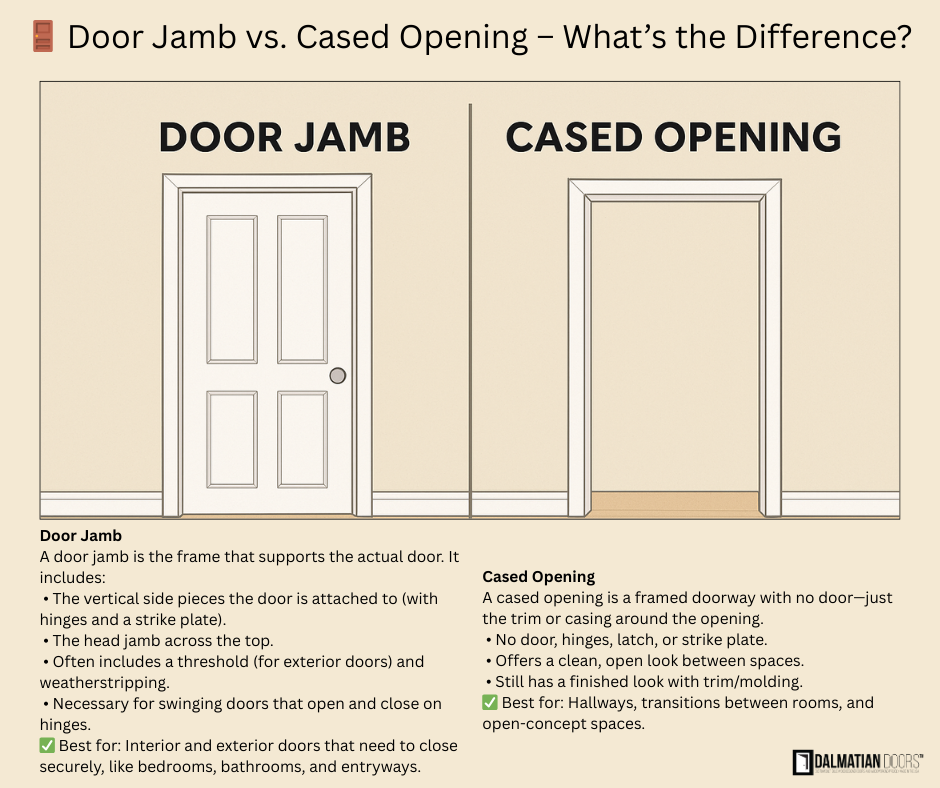Door Jamb vs. Cased Opening – What’s the Difference?
Apr 16th 2025
When it comes to doorways, not all are created equal—and not all require an actual door. Whether you’re remodeling your home or planning new construction, understanding the difference between a door jamb and a cased opening can help you make the right choice for your space and function.
What Is a Door Jamb?
A door jamb is the structural framework that supports a door within a wall opening. It’s made up of:
• Side jambs: The vertical parts of the frame, one of which holds the hinges, the other the latch or strike plate.
• Head jamb: The top horizontal part of the frame.
• Optional components: For exterior doors, jambs often include a threshold and weatherstripping.
The door jamb ensures the door opens and closes smoothly, stays aligned, and has a solid structure to rest against when shut.
✅ Best for:
• Bedrooms
• Bathrooms
• Closets
• Exterior doors
• Any area where privacy, sound control, or security is needed
What Is a Cased Opening?
A cased opening is a framed doorway without a door. It’s simply an open passage between rooms, finished with trim or molding to give it a clean, polished look.
There are no hinges, strike plates, or door hardware. Just the casing (trim) around the wall opening, making it ideal for spaces where you want visual separation without limiting flow.
✅ Best for:
• Dining rooms
• Living room/kitchen transitions
• Hallways
• Open concept homes
Visual Difference at a Glance
| Feature | Door Jamb | Cased Opening |
|---|---|---|
| Includes Door? | ✅ Yes | ❌ No |
| Hinges/Hardware? | ✅ Yes | ❌ No |
| Used For? | Private, secure areas | Open, pass-through spaces |
| Look & Feel | Functional & finished | Open & airy |

Which One Do You Need?
Choosing between a door jamb and a cased opening depends on how the space will be used:
• Want privacy and sound control? Go with a door jamb.
• Prefer openness and flow between rooms? A cased opening may be your best bet.
Final Thoughts
Both door jambs and cased openings serve a purpose in home design. Whether you want a sleek, functional entry or an open, welcoming transition, knowing the difference helps you plan smarter and build better.
Need help choosing the right fit for your project? Contact us today to explore our solid wood door and trim options!
Door Jamb vs. Cased Opening – Quick Comparison
| Feature | Door Jamb | Cased Opening |
|---|---|---|
| Description | A frame that supports a swinging door. Includes side jambs, head jamb, and often threshold and weatherstripping. | A framed doorway with no door—just trim/molding for a finished look. |
| Hardware | Includes hinges, strike plate, and sometimes threshold. | No hinges, latch, or strike plate required. |
| Functionality | Allows door to open/close for privacy, noise control, and security. | Maintains an open flow between rooms with no physical barrier. |
| Best For | Interior and exterior doors: bedrooms, bathrooms, entryways. | Open-concept layouts: hallways, dining/living transitions. |
Tip: If you’re unsure which one is right for your project, think about the function of the space:
Need privacy or separation? Go with a door jamb.
Want an open flow? A cased opening is your friend.





